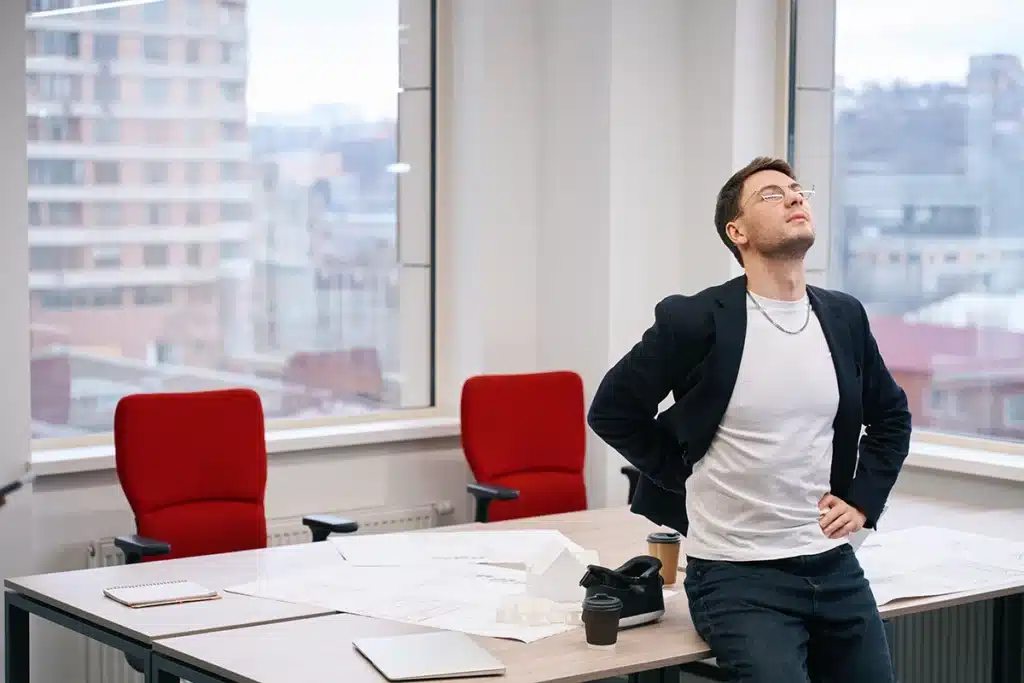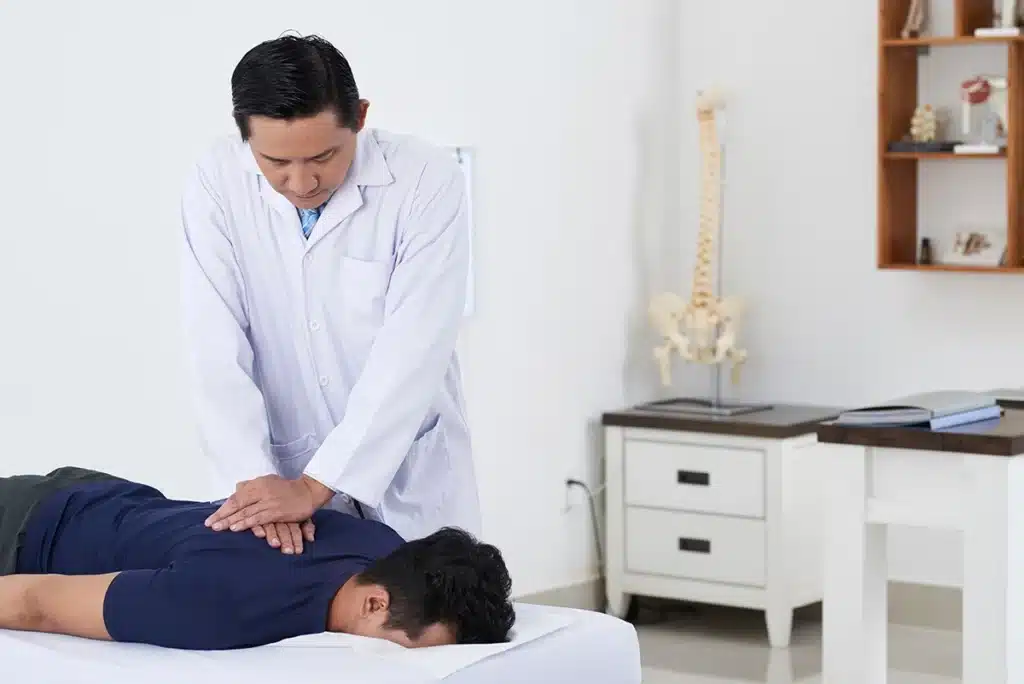
Table of Contents
ToggleScoliosis is a term many have heard, but few truly understand. It’s a condition characterized by an abnormal curve in the spine.
For those living with it, back pain relief for scoliosis isn’t just a desire; it’s a necessity to lead a comfortable life.
At Long Island Neuroscience Specialists, we understand the unique challenges that scoliosis patients face, especially when it comes to back pain.
For those seeking back pain relief for scoliosis, it’s essential to be equipped with the right information and relief strategies.
Scoliosis, a condition that affects countless individuals worldwide, is marked by an abnormal curvature of the spine. But what does this mean for those who suffer from it?
At its core, scoliosis pain is a direct result of the spine’s misalignment. Imagine the spine as a well-balanced structure; when it curves unnaturally, it disrupts this balance. This curve can place uneven pressure on different areas of the back, leading to a myriad of pain experiences.
Some may feel it deep within the muscles, while others might experience it as pressure on the bones or even nerve pinches. The intensity and location can vary based on the degree and location of the curvature.
Pain’s manifestation in scoliosis is as diverse as its roots. Some describe it as a consistent dull ache that they’ve grown accustomed to, while others are jolted by sharp, unexpected stabs, especially after certain activities or movements.
Physical activities, even simple ones like walking or bending, can intensify this pain. Furthermore, prolonged periods of sitting or standing without proper support can exacerbate the discomfort, making tasks that seem mundane to others a challenge for those with scoliosis.
This wide-ranging pain experience emphasizes the need for a comprehensive approach to managing and understanding scoliosis pain. By diving deep into its nature, we can better equip ourselves to handle it.
Living with scoliosis often means navigating through a world of activities while striving for back pain relief for scoliosis. Recognizing and understanding the potential triggers can greatly aid in managing the discomfort that comes with the condition.
In today’s modern era, many of us are guilty of bad posture habits. Hours spent hunched over smartphones, slouching in front of computer screens, or binge-watching our favorite shows can wreak havoc on our backs.
For someone with scoliosis, these postural pitfalls can amplify the pain. Similarly, sleeping without adequate back support or consistently carrying heavy bags on one shoulder can further strain the spine.
To achieve back pain relief for scoliosis, it’s essential to be mindful of these daily habits and work towards maintaining a correct posture.
Physical activities are beneficial for overall health, but it’s crucial to differentiate between what’s helpful and what might be harmful. Engaging in high-intensity workouts without proper technique or consistently lifting heavy objects without proper form can place undue strain on an already curved spine.
For those seeking back pain relief for scoliosis, it’s vital to customize workout routines that strengthen the back without exacerbating the pain.
Aging is a natural process, and with it comes the inevitable wear and tear of the body, including the spine. For those with scoliosis, the changing dynamics of an aging spine can bring about more pronounced pain levels.
Many wonder, “Does scoliosis get worse with age?” The answer isn’t straightforward. While some may experience a stabilization of their condition, others might see a progression in the curvature and associated pain.
Regular check-ups and consultations with specialists can help in tracking these changes. Adapting to them with the right interventions and strategies can pave the way for effective back pain relief for scoliosis even in the later years.
By being aware of these aggravating factors and proactively addressing them, one can lead a life that doesn’t revolve around pain, but instead focuses on well-being and comfort.

Dealing with scoliosis can be a challenging journey, but the silver lining is that there are multiple strategies to achieve back pain relief for scoliosis.
Knowing the right methods and staying informed can make a world of difference.
Remember, while OTC meds are easily available, it’s essential to use them as directed and ensure they don’t interfere with any other medications you might be taking.
The experienced team at Long Island Neuroscience Specialists has the expertise to evaluate the severity of your pain and recommend prescription solutions tailored to your needs.
They can provide an optimized combination of medications and therapies that align with your specific scoliosis condition.
For those looking for a non-medicinal approach, physical therapy shines brightly. More than just exercises, physical therapy is a holistic approach to back pain relief for scoliosis.
Relief from recurring pain: With consistent therapy, many patients report a marked decrease in the frequency and intensity of their pain.
Can a chiropractor fix scoliosis? To understand the potential benefits and limitations of chiropractic care, it’s essential to dive deeper into the world of chiropractic solutions.
While the primary goal of chiropractic care isn’t to “fix” or entirely straighten the scoliotic curve, its benefits are vast and multifaceted. For many scoliosis patients, chiropractic adjustments have become a cornerstone of their pain management routine. Here’s why:
The potential benefits in terms of pain relief, improved posture, and enhanced mobility make it a valuable tool in the scoliosis treatment arsenal.
The realm of medical science is like an ever-flowing river, always moving, always evolving. As we forge ahead, newer treatments and methodologies are being researched and tested.
It’s a beacon of hope for those seeking advanced back pain relief for scoliosis. Being affiliated with or consulting healthcare professionals like those at Long Island Neuroscience Specialists can offer you insights into these innovative treatments.
Their vast experience and commitment to patient well-being mean they are always abreast of the latest advancements, ensuring you get the best care possible.
Having the right medical professional by your side is like possessing a compass in this journey. The significance of selecting the right expert transcends just medical advice; it’s about understanding, guidance, and a tailored approach that suits your unique condition.
Long Island Neuroscience Specialists stand out in this regard. Their commitment to excellence and patient well-being sets them apart.
In essence, when seeking back pain relief for scoliosis, entrusting your care to dedicated professionals like those at Long Island Neuroscience Specialists ensures you’re not just another patient but a valued individual deserving of the best treatment and attention.

Living with scoliosis often means adjusting one’s lifestyle to find the best strategies for comfort and back pain relief for scoliosis. Incorporating minor changes can make a world of difference in daily comfort levels and long-term spine health.
Each individual might have specific triggers that exacerbate pain.

Back pain relief for scoliosis is a journey, not a destination. With consistent care, the right medical support, and informed choices, living with scoliosis doesn’t mean living in pain.
If you or a loved one needs back pain relief for scoliosis, don’t wait. Reach out to Long Island Neuroscience Specialists. We’re here to guide, support, and help you lead a pain-free life.
As you seek back pain relief for scoliosis, remember that you’re not alone on this journey.
GET IN TOUCH +
285 Sills Road
Building 5-6, Suite E
East Patchogue, NY 11772
(631) 475-5511
184 N. Belle Mead Road
East Setauket, NY 11733
(631) 675-6226
GET IN TOUCH +
285 Sills Road
Building 5-6, Suite E
East Patchogue, NY 11772
(631) 475-5511
184 N. Belle Mead Road
East Setauket, NY 11733
(631) 675-6226
SUBSCRIBE TO OUR NEWSLETTER +
Send us a Google review. Click this link and let us know how we did!
Review us on Yelp too.